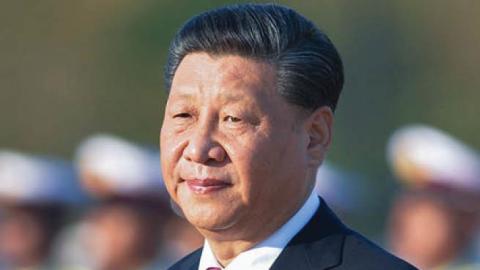COVID-19 has demonstrated how poorly the Western political establishment interpreted Chinese intentions. Gone is the economic-political optimism that began in the 1990s, which predicted that commercial integration would ultimately transform the Chinese regime.
Of greater importance is the demonstrable failure of “congagement,” a portmanteau describing the policy of consistent economic contact and limited strategic-economic engagement. Limited measures — the long-dead Trans-Pacific Partnership, the “Pivot to Asia,” the focus on Freedom of Navigation Operations (FONOPS) — were thought to provide enough “notice” to China by supporting the vaunted “Rules-Based International Order” without prompting escalation. Concurrently, maintaining and increasing economic interaction were supposed to advance the possibility of liberal integration and moderation.
This latter policy was more damaging than the initial rosy estimates of Chinese liberalization. Traditional military responses simply emboldened China, which is as confident in its growing “anti-access/area-denial” (A2/AD) capabilities as it is wholly aware of the U.S.’s diminishing regional power. The legalistic FONOP framework lacked the substance to serve as a deterrent, while the vaunted “Pivot to Asia” failed because budgetary restrictions shrank the U.S. Navy’s combat fleet between 2008 and 2016. Moreover, FONOPs generally are restricted to a small number of ships that serve as a political-diplomatic signal, not a military deterrent.
Indeed, this division between political signaling and strategic action arguably defines American policy mistakes toward China. General American policy discourse makes a distinction between international politics — that is, diplomacy — and war. This trend is bipartisan and multi-generational, which is as clear in the Powell Doctrine’s strict intervention criteria and the debates over the Iraq War as it was in debate over President Trump’s “maximum pressure” approach to North Korea and Iran.
American historical experience demonstrates its limited applicability to contemporary conflict. The Civil War and World War II are defining victories in the American historical consciousness; each was aimed at an adversary’s destruction, which precluded any substantive diplomacy.
By contrast, American failure in Vietnam resulted from an incoherent approach blending force and diplomacy, thereby restraining U.S. military action and forcing it into an “unwinnable” counterinsurgency campaign. The overwhelming American victory in the Gulf War, compared with the “quagmire” of Iraq and Afghanistan, reified this perception. One expects that this perceived binary between conflict and peacetime will characterize the perception of the next administration, particularly if a victorious Joe Biden turns to the same Obama-era appointees who crafted the previous president’s ineffectual foreign policy.
The danger of this view is that America’s adversaries do not share it. Russian “hybrid warfare,” for example, includes actions from ransomware and cyberattacks against civilian bank servers to covert interventions, pseudo-traditional military operations, and the credible threat of nuclear use. Its political pressure on behalf of Ukrainian President Yanukovych in 2013 (and, one suspects, Belarusian President Lukashenko today) is not “diplomacy” but is inextricable from hybrid military means. Similarly, Iran’s methods of state capture in Iraq were simultaneously political, diplomatic, military and economic. Tehran bankrolled and thereby controlled otherwise divided Shia paramilitaries that were (and remain) suspicious of Iranian motives while concurrently playing to former Prime Minister Maliki’s sectarian fears and deploying expeditionary forces when necessary.
China’s attempts to mobilize overseas populations — which it views as duty-bound to China — to steal intellectual property from the West constitute a similar form of aggressive manipulation. There is no line in these actions between “peacetime” and “warfare.”
Even more dangerous, America’s adversaries seem to understand the nature of politics far better than we do. Stemming from Plato and Aristotle, the defining thinkers of the Western Canon have identified politics as a competitive activity, particularly between political units. One need not be a Hobbesian to understand the roots of this competition: Men fear one another, love their friends, hate their enemies, crave land and wealth for security and to satisfy, as Jefferson so delicately put it, their “happiness.”
As competition and violence are an essential aspect of political interaction, it is not surprising that a major thinker within the Western Canon, the Prussian officer-philosopher Carl von Clausewitz, undertook a philosophical study of warfare in his seminal, unfinished text, “Vom Kriege,” or “On War.” Better known to students of military sciences than to those of politics and philosophy, the work’s brilliance lies in its ability to guide the reader through the remarkably complex phenomenon of warfare using a series of metaphors and comparisons which build upon one another, helping readers see intellectual connections between parts of the phenomenon until the whole is grasped.
Clausewitz’s two most striking statements come in the first chapter. War, he contends, is “an act of force to compel the enemy to do our will” and “a continuation of politics by/with the addition of other means.” Lexically and syntactically, these statements are meant to be combined. “An act of force to compel the enemy to do our will,” Clausewitz argues, is “a continuation of politics with the addition of other means.” The political is constant, intended to impose one’s will upon another. There are neither bright nor fuzzy distinctions between the ends of warfare and diplomacy. Only the means differ.
Chinese policy reflects the world’s most refined example of Clausewitzean ideas. The object of Chinese actions is not simply subversion, domestically directed saber-rattling, or some other indirect objective. The regime will not abide by an international agreement that limits its ability to increase its power and prestige. Its political choices feed into a clear military strategy: Use overwhelming missile barrages and local naval superiority to gain control of the First and Second Island Chains while, if possible, employing detached surface action groups and submarines from global bases to pressure the United States outside of the Asia-Pacific. Every Chinese infrastructure project has dual-use capability, from the railroad networks it hopes to finance in Southeastern Europe to the Mediterranean and Indian Ocean ports from which it has fashioned a pearl necklace. Even outside of an explicitly military context, by gaining control over a target state’s infrastructure and economy, China can manipulate it during a crisis to, say, drive a wedge between NATO allies like Hungary and the rest of the alliance.
Competing with China requires grasping this total view of political rivalry. One could term it “political warfare,” although not in the conventional sense. The term captures the dynamic interaction between military and non-military elements of Chinese national power toward the single goal of defeating the United States and destroying the international order upon which American power rests.
The “whole of government” idea that has gained currency in U.S. foreign/national security policy circles as an answer to Beijing’s global challenge is necessary but insufficient. Needed still is a comprehensive understanding that all of China’s external (and much of its domestic) action is anchored in achieving — at a minimum — dominance over the U.S.

















